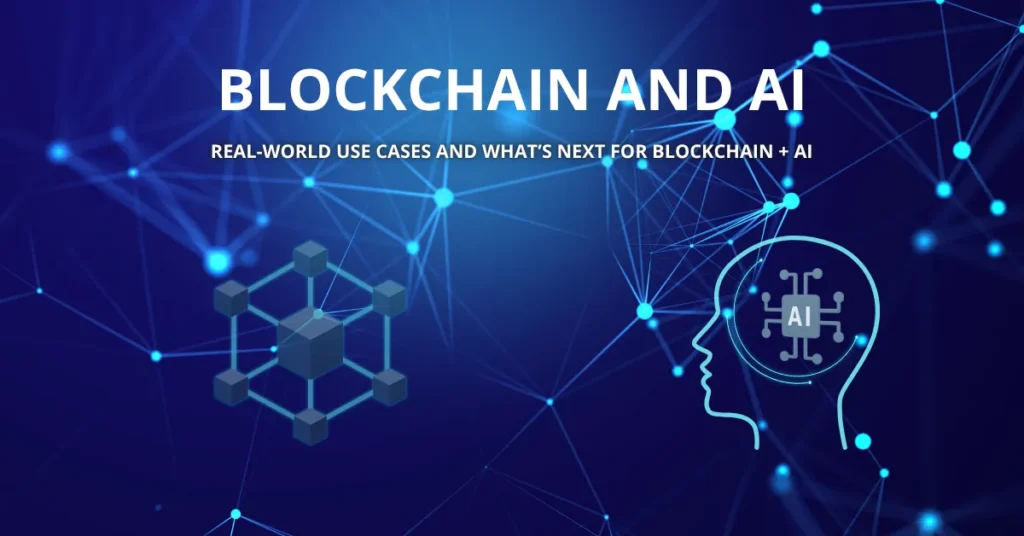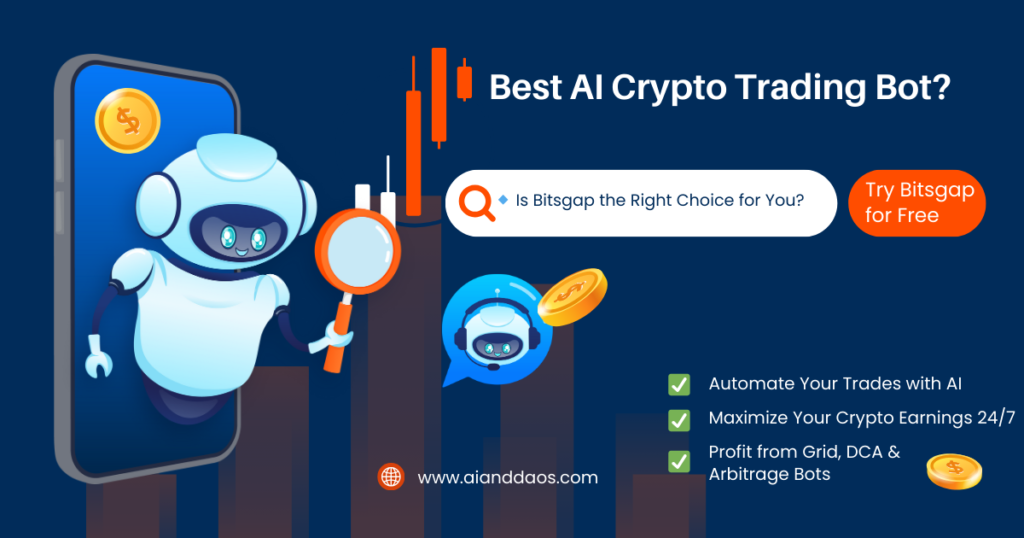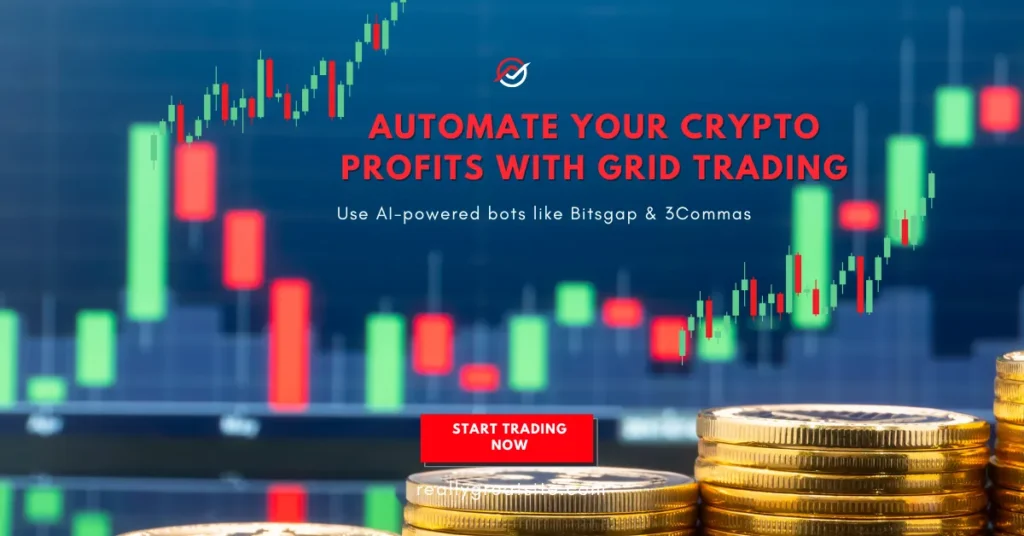Understanding the Power of Blockchain and AI
What happens when you combine the trust of blockchain with the intelligence of AI? You get more than just a buzzword—you get smarter, more secure systems that don’t rely on a single authority to function.
Blockchain and AI are two of the most powerful technologies shaping the digital world. On their own, they’ve already changed how we store data, automate tasks, and make decisions. For example, blockchain helps keep medical records safe from tampering, while AI supports faster, more accurate diagnoses. In finance, AI spots fraud in real time, and blockchain ensures that those transactions stay transparent and can’t be altered.
Now imagine what’s possible when these two technologies work together—learning from data, making decisions, and staying secure, all without needing one company or central system in charge.
In this guide, we’ll break down what blockchain and AI are, how they work together, and why this combination matters. You’ll see real-world examples, explore the benefits and challenges, and get a glimpse of what the future of decentralized tech could look like.
Whether you’re just curious or looking to understand where all of this is headed, this is the place to begin.
How Revolutionary AI and Blockchain Integration is Transforming DAOs in Web 3.0
What Are Blockchain and AI? A Quick Overview
Let’s start with the basics. Before we talk about how blockchain and AI work together, it’s important to understand what each of them actually is—and why they matter.
What is Blockchain Technology?
Think of blockchain like a digital notebook that’s shared across thousands of computers. Every time someone adds something to it—like a transaction or a record—it gets stored in a block. Once that block is full, it’s sealed and linked to the next one, forming a chain. Hence the name, blockchain.
What makes it special is that no one can secretly change the information later. Everything is open, secure, and stored in a way that can’t be easily tampered with. That’s why it’s called decentralized—there’s no central owner. It’s most famous for powering cryptocurrencies like Bitcoin, but its real value goes far beyond that.
How Blockchain Technology in Agriculture Works
What is Artificial Intelligence?
Now let’s look at AI, or Artificial Intelligence. This is the technology that helps machines “think” by analyzing data and making decisions. It doesn’t mean robots with feelings—it means software that can recognize patterns, predict outcomes, and perform tasks automatically.
You’ve probably used AI without even realizing it. When Netflix recommends a show, when Google finishes your sentence, or when your phone unlocks with your face—that’s AI at work.
AI is great at making things faster, smarter, and more efficient.
Why Do They Work So Well Together?
Here’s where things get really interesting. Even though blockchain and AI are very different technologies, they actually work really well together—and even complement each other in ways that solve each other’s weaknesses.
Blockchain is all about secure data sharing, transparency, and creating trustless systems—where no central authority is needed to verify what’s true. Artificial Intelligence is excellent at analyzing large amounts of data, spotting patterns, and making fast, intelligent decisions. But AI has one significant drawback—it can be a black box. You often don’t know exactly how a decision is made, which raises concerns about AI transparency and accountability.
That’s where blockchain helps. Recording decisions and data on a decentralized ledger adds a layer of auditability and trust to AI’s actions. On the flip side, AI can improve blockchain systems through automation, efficiency, and more intelligent decision-making. This combination leads to blockchain-based automation and decentralized decision-making that’s both intelligent and trustworthy.
Put, when blockchain and AI work together, you get systems that are smart, secure, and decentralized. And that’s a big step forward for the future of tech.
Why Combine Blockchain and AI?
At first, blockchain and AI might seem like very different technologies—but they actually solve some of each other’s biggest challenges. And that’s exactly why combining them makes so much sense.
Let’s start with AI. It’s smart, fast, and great at analyzing data to make decisions. But it has two major issues: it needs reliable, high-quality data, and it can often act like a black box—you don’t always know how or why it made a decision. This creates concerns around AI trust and accountability.
That’s where blockchain steps in. Blockchain is built for transparency, data integrity, and decentralized storage. It keeps records that can’t be changed or erased, making it a perfect foundation for trustworthy AI systems. When AI uses data stored on a blockchain, that data is verifiable and secure—so its decisions are based on something solid.
And it works both ways. While blockchain improves AI transparency and trust, AI helps blockchain scale and adapt. AI can automate complex decisions, manage smart contracts more efficiently, and optimize operations in decentralized systems. This leads to secure automation and better performance across networks.
So, when you combine blockchain and AI:
- AI adds intelligence and learning
- Blockchain adds trust, traceability, and accountability
Together, they enable systems that are not just fast and smart—but also secure, explainable, and decentralized. That’s what makes this combo a game-changer for the future of AI governance, digital infrastructure, and beyond.
Real-World Use Cases of Blockchain and AI
You might not notice it yet, but blockchain and AI are already working behind the scenes—in hospitals, cities, and even the apps you use every day. Together, they’re quietly starting to reshape the way the world operates.
Healthcare
Did you know that AI can detect certain cancers faster than trained radiologists? And blockchain is helping protect the sensitive medical data behind those predictions.
Hospitals are already testing systems where your full medical history is stored on the blockchain, shared only when you allow it, and instantly analyzed by AI to catch warning signs early.
It’s smart, private, and could save lives—especially in places with limited doctors.
Supply Chain
In 2020, IBM and Walmart used blockchain to track mangoes from farm to shelf in just 2.2 seconds—a process that used to take 7 days!
Now imagine pairing that with AI, which can forecast weather, crop yields, or even labor shortages. Together, they help companies deliver faster and spot fake or unsafe products before they reach you.
Think of it like giving the global supply chain X-ray vision.
How to Invest in Web3 Supply Chain Tokenization & Get Ahead of Institutions
Finance & DeFi
Banks spend billions fighting fraud. But AI can detect unusual patterns in seconds—like someone using your card in two countries at once. Then, blockchain records every transaction so nothing can be erased or tampered with.
Projects like Aave and Compound already use blockchain and AI to let people borrow and lend crypto automatically—no bank needed.
Welcome to a world where money moves faster, cheaper, and more fairly.
Smart Cities & IoT
In South Korea, cities like Sejong are experimenting with blockchain-powered smart traffic systems, where AI makes decisions in real time—like when to turn green lights on or redirect traffic during an accident.
Blockchain keeps those decisions transparent and secure, reducing the risk of hacking or data misuse.
This isn’t science fiction—we’re already testing cities that think on their own.
Digital Identity
Over 1 billion people in the world don’t have any official ID. That means they can’t open a bank account, vote, or access basic services.
Now, projects like ID2020 and Estonia’s e-Residency are using blockchain and AI to build self-sovereign digital identities. You control it—AI confirms it’s you, and blockchain keeps it safe.
Imagine owning your identity like you own your home—no passwords, no paperwork, just proof.
From Centralized AI to Decentralized Intelligence: A New Era?
Let’s walk through this together.
Right now, most of the AI we use—like chatbots, social media feeds, and search engines—is controlled by a few large tech companies. This is called centralized AI. These companies decide how the AI works, what data it learns from, and how the results are used. We, as users, get the benefits—but we don’t get much say in the process.
The problem is, centralized AI often lacks transparency. We don’t know how decisions are made or whether our data is being used fairly. It raises big concerns around data ownership and control.
Now imagine something different—something more open.
With blockchain technology, we can move toward decentralized intelligence. That means AI systems that are built and run by communities, not just corporations. Blockchain governance allows people to make decisions together. The data and models are open-source, and everyone can see how the AI works—adding a layer of trust and accountability.
Thanks to tools like DAOs, people can come together to train AI, vote on changes, and even earn tokens for contributing data, feedback, or development work. This creates a shared system where AI is community-driven and no one person or company holds all the power.
This is still an emerging space—but it’s a big shift. With blockchain and AI combined, we may be heading into a future where intelligence is decentralized, transparent, and shaped by all of us—not just the few at the top.
Current Projects Bridging Blockchain and AI
Let’s take a look at some real-world projects that are already combining blockchain and AI. These aren’t just ideas—they’re up and running, showing us how the two technologies can work together in powerful ways.
Fetch.ai – Agents That Work for You
Imagine a small piece of software that can act on your behalf—booking flights, trading tokens, or managing your energy use—without you lifting a finger. That’s what Fetch.ai is building.
They call these tools autonomous economic agents. These agents use AI to make smart decisions and blockchain to handle secure transactions and communication. Everything they do is recorded and verified on-chain.
This helps people and businesses automate tasks while keeping things transparent and decentralized.
SingularityNET – A Marketplace for AI
What if you could buy or sell AI tools the same way you shop for apps?
Developers from around the world can upload their AI models—like language translators, voice assistants, or image analyzers—and others can pay to use them with cryptocurrency.
It runs on the blockchain, so payments are handled by smart contracts and everything is transparent. It’s like giving independent AI developers a platform where no big company is in charge.
Ocean Protocol – Sharing Data the Smart Way
AI needs a lot of data to learn—but sharing that data is risky. What if it leaks or gets misused?
Ocean Protocol solves this by making it safer to publish, share, and monetize data using blockchain. People or companies can list data sets (like weather reports or medical research), and others can use them to train AI—without ever owning or downloading the raw data.
It keeps control in the hands of the data owners, while still supporting AI development. This is especially useful for privacy, research, and ethical AI.
Other Projects Worth Noting
There’s even more happening at the edge of blockchain and AI—and some of these projects are doing things you wouldn’t expect.
Take Numerai, for example. It’s not your typical hedge fund. Instead of hiring a few data scientists, it invites thousands to submit their own AI models. The best ones help guide investments—and the creators earn rewards. It’s like turning the stock market into a global AI competition, backed by blockchain for fairness and transparency.
Then there’s Cortex, which is doing something bold: letting developers run AI models directly on the blockchain. That means smart contracts can go beyond basic commands—they can actually think and adapt in real time.
DeepBrain Chain is all about cutting costs. Training AI is expensive, but this project offers decentralized computing power, making it way more affordable—especially for indie developers and startups.
And dClimate? It’s using AI and blockchain to make climate forecasts more accurate and open. That’s a big deal for farmers, insurers, and anyone planning for a world where weather patterns keep changing.
Each one of these projects is pushing boundaries—and proving that the future of AI doesn’t have to live in Big Tech’s walled garden.
Key Challenges in Combining Blockchain and AI
Let’s slow down for a moment. While putting blockchain and AI together opens up some powerful possibilities, there are still some important challenges to think about. If you’re learning how these systems work, here’s what you need to understand:
1. Technical Limitations
AI needs speed. It works best when it can process large amounts of data quickly. But blockchain isn’t built for speed—it’s built for security and trust. That means we run into issues like slow processing times (latency) and limited scalability. Also, both technologies can be energy-intensive, especially if you’re using older blockchain systems like Bitcoin.
2. Privacy vs. Access
AI learns from data. The more data it has, the better it can perform. But here’s the catch: blockchain is public by design. Everything recorded on it is visible to everyone. So how do we give AI enough data to learn, while still keeping personal or sensitive information private? That’s a tough balance to strike.
3. Trust and Bias
AI is only as good as the data it learns from. If that data is biased or incomplete, the AI’s decisions can be too. In a decentralized setting, where many people contribute to training models, it’s even harder to make sure the data is clean and fair. So the big question is: How do we build trust in AI that isn’t controlled by one group or company?
4. Cost and Infrastructure
Both blockchain and AI require powerful computers and reliable internet. This makes them expensive to run—especially if you’re in a place without strong tech infrastructure. Also, in many countries, regulations around data, AI, and crypto are still unclear, which can slow down development or block innovation altogether.
What the Future Holds for Blockchain and AI
Let’s look at where things are headed.
In the coming years, we’ll likely see the growth of decentralized autonomous systems—setups where AI can operate without needing a central authority, powered instead by smart contracts on blockchain. These systems could manage tasks automatically, securely, and with no human in the loop, offering efficiency and transparency at the same time.
Another major shift is the idea of AI models being governed by communities. Right now, most AI is controlled by big companies. But with tools like DAOs, we may see more community-driven AI, where people collectively decide how an AI is trained, used, and improved. This brings AI governance into public hands instead of corporate ones.
As blockchain continues to expand, it will connect more deeply with Web3 tools, interoperable platforms, and even DePIN (Decentralized Physical Infrastructure Networks). This means smarter, more connected ecosystems—where blockchain and AI power real-world tools, from smart cities to decentralized energy grids.
Of course, with all this progress comes responsibility. We’ll need to address key issues like data privacy, bias, and ethical AI development. As systems become more intelligent and decentralized, questions about who controls them and how they impact society will matter more than ever.
In short, the future of blockchain and AI is not just about faster systems—it’s about building ones that are fair, open, and aligned with human values. And we’re just beginning that journey.
What You Should Take Away
Here’s the big picture: when you combine blockchain and AI, you get systems that are not just smart—but also transparent, secure, and community-driven.
Blockchain brings trust and accountability. AI brings speed and decision-making power. Together, they offer a new way to build technology—one that gives users more control and makes systems easier to verify and improve.
We’re still early in this journey. Most projects are just getting started, and the full potential of decentralized intelligence is still being explored. But even now, we can see how powerful this combination could be—in healthcare, finance, identity, climate, and beyond.
If this topic sparks your interest, keep exploring. Whether you’re into tech, ethics, innovation, or future systems, learning how blockchain and AI work together is a great way to understand where the next chapter of the internet is heading.
FAQs About Blockchain and AI
Q. Can AI run on a blockchain?
Sort of—but with limits. Most AI systems are too large and complex to run entirely on a blockchain. However, parts of the process—like storing decisions, verifying results, or triggering smart contracts—can be handled on-chain. Some platforms like Cortex are working on making this more practical.
Q. Are there real companies using both technologies today?
Yes! Projects like Fetch.ai, SingularityNET, and Ocean Protocol are already combining blockchain and AI in real-world ways. From decentralized marketplaces to data-sharing platforms, these companies are pushing forward how both technologies work together.
Q. Is Blockchain necessary for AI?
Not always—but it can make AI more transparent, secure, and community-governed. Blockchain adds trust, auditability, and control—especially important when AI is being used to make decisions that affect people’s lives.
Q. How does this impact everyday users?
For most people, it means the future of tech could become more open and user-friendly. You might gain better control over your data, clearer insight into how decisions are made, and even opportunities to participate in building or governing intelligent systems—without needing to be a coder.



Pingback: AI in DeFi: How Artificial Intelligence is Redefining Decentralized Finance - AI and DAOs
Pingback: How AI and Blockchain Integration Enhancing DAOs in Web 3.0
Pingback: AI in Web3 Content Creation: Innovating DAOs
Pingback: Implement AI in DAOs: A Guide to Smarter Governance
Pingback: Tokenized Real-World Assets (RWAs) Explained